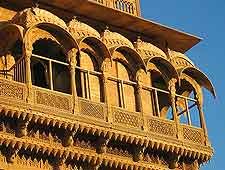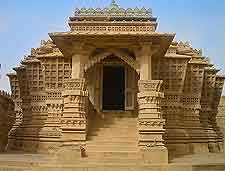Jaisalmer History Facts and Timeline
(Jaisalmer, Rajasthan, India)

Once a state in its own right, the Rajasthani city of Jaisalmer lies in the arid Thar Desert and is known as the 'Golden City' for its use of the local glowing, yellow sandstone.
Set on a ridge, the city's fort sits at its highest point and contains the ruler's palace, along with ornately-carved Jain temples and houses. The history of Jaisalmer began in medieval times with its founding by Rawal Jaisal in 1156 as his new capital city, replacing Lodhruva, some 15 km / 9 miles to the north-west.
A New Capital is Born
The new capital flourished and became wealthy for well over 100 years, due to its position on the camel trade route between central Asia and India. However, it was sacked in 1293 by the armies of Delhi's ruler, Alauddin Khilji, after a nine-year siege.
Subsequently, although the ruling dynasty maintained friendly relations with Mughal Delhi, the city found itself under attack several times in this period of Jaisalmer history. By the 17th century, it was again prosperous and wealthy, featuring a large number of grand palaces, mansions and temples.

The 19th Century
In the 19th century, the rise of Bombay, now
Mumbai, as India's main shipping port greatly reduced the influence of the ancient trade routes and caused economic decline in Jaisalmer, which was exacerbated by severe water shortages. Given the flowering of the arts and religion in the city, Jaisalmer's cultural influence never waned and can still be seen today in its exquisitely-carved homes, mansions, temples and palaces, which gave it the 20th century nickname of the 'Museum City'.
The British Raj Era
During the years of the British Raj, the remoteness of Jaisalmer protected the city-state from foreign colonial influence, with attention given instead to the other Rajasthani city-states of
Jodhpur and
Jaipur. Jaisalmer had been the last princely state to sign the 1818 treaty with the British, which gave status and control to Rajasthan under its rulers, who preferred to be left in peace.
Conflict and Tourism
International conflict between India and Pakistan dragged the city onto the world agenda during the Indo-Pakistan Wars of 1965 and 1971, due to its strategic position.
Finally, its water shortages were solved by the building of the Indira Gandhi Canal and the city became a permanent hub for the Indian military. Nowadays, Jaisalmer and its fascinating history are again the centre of a new and very lucrative trade route - that of international tourism. The city attracts huge numbers of visitors from across the world each year, who come to admire its ancient forts, palaces and spectacular temples.
 Once a state in its own right, the Rajasthani city of Jaisalmer lies in the arid Thar Desert and is known as the 'Golden City' for its use of the local glowing, yellow sandstone.
Once a state in its own right, the Rajasthani city of Jaisalmer lies in the arid Thar Desert and is known as the 'Golden City' for its use of the local glowing, yellow sandstone.